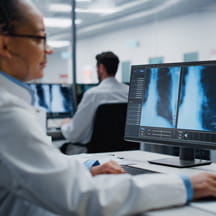After years working as a physician for children who experienced child abuse, severe neglect, exploitation or trafficking, Jordan Greenbaum retired from the health care setting. She’s now the medical director at the International Centre for Missing and Exploited Children, using her skills to combat child trafficking and exploitation worldwide.
The organization emphasizes that a health care professional’s role is not to rescue kids but to recognize vulnerable children and mitigate their risk of exploitation, which is an area where children’s hospitals can help.
“As health care professionals, we have a role to play in recognizing children who are experiencing or who are at risk for trafficking,” she says. “With that comes the responsibility to learn about potential indicators, clinically validated screening tools, the optimal approach to patient interaction and available resources.”
According to Greenbaum, a child at risk of exploitation or trafficking often has one or more risk factors, such as:
- Homelessness.
- Family substance misuse.
- Living in communities that tolerate commercial sex.
- Being identified as belonging to a group that is marginalized by society.
Greenbaum shares her insight into how children’s hospitals can mitigate child trafficking and exploitation.
How widespread is child exploitation?
We lack reliable estimates of the prevalence of child exploitation in the United States, but the most recent global estimates suggest that nearly 25 million individuals were involved in forced labor in 2016, and 4.5 million of those were children.
Why are children’s hospitals an ideal place to identify children at risk of and experiencing exploitation?
There is evidence that many children who experience trafficking seek health and mental health care shortly before, during or after their period of exploitation. They may be treated in hospital emergency departments, outpatient settings, or inpatient units, including intensive care units, behavioral health units or teen clinics.
The specific reason for accessing care may be related to the trafficking experience itself—for example, a sexually transmitted infection, work-related injury or suicidal ideation. Or it may be related to exacerbation of a chronic disease, such as asthma or diabetes.
What is the biggest barrier to identifying children at risk of trafficking?
Barriers to identification exist at multiple levels.
At the level of the patient, a child may be reluctant to disclose their exploitation due to fear of harm by a trafficker; fear of deportation, arrest, or involvement of child welfare; or feelings of shame or guilt. In many cases individuals do not disclose a trafficking experience because they do not perceive their condition as exploitative. This may be due to manipulation by a trafficker or a child’s lack of knowledge of cultural norms and labor laws.
At the level of the health care provider, the biggest barrier is a lack of training and education about child trafficking—but biases and discrimination may also affect our ability to recognize a child at high risk.
At the level of the organization, a lack of protocols and guidelines on child trafficking hinders the ability of staff to recognize children who are being exploited and those at risk.
What are the most common signs children’s hospital staff should look out for?
There are several signs that may serve as red flags of child trafficking, although these may be absent, or may be associated with circumstances other than trafficking:
- The person accompanying the child appears domineering or intimidating, not allowing the child to answer questions, being reluctant to leave the child alone with staff or resisting use of a professional interpreter.
- The child appears intimidated, afraid, depressed or anxious.
- The child has symptoms of a condition commonly associated with human trafficking, such as post-traumatic stress disorder, teen pregnancy or a preventable work-related injury.
- The child shows signs of intravenous substance use or injuries suggestive of inflicted trauma.
If a health care provider suspects a patient may be experiencing exploitation, what is the first step that person should take?
The professional should assess the child’s safety and their risk for exploitation by asking open-ended questions about areas of concern. Keep in mind that the goal is not to elicit a disclosure of trafficking, but instead to assess the level of risk and the need for resources.
A child at risk for trafficking requires support and resources similar to the one who is experiencing exploitation. Further, mandatory reporting laws require the professional to report when there is a “reasonable concern” for human trafficking—the provider does not need to be certain a crime occurred.
The professional needs to assess and address risks and vulnerability, offer support in the form of resources, and ensure the child understands that if they choose to decline referrals and services, they may return to the hospital or clinic for help in the future.
What is a good starting point for health care professionals looking to educate themselves or their teams on child exploitation?
Fortunately, there is no shortage of available resources for health care professionals interested in learning to recognize and respond to child trafficking and exploitation. The Child Health PSO® Patient Safety Alert on Improving Identification of Patients at Risk for Human Trafficking sets a good foundation for this issue and provides training opportunities and protocol development for children’s hospitals.




